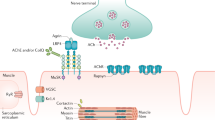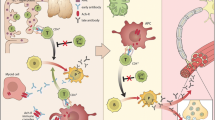Abstract
Myasthenia gravis (MG) is an autoimmune disease, caused by IgG antibodies to postsynaptic proteins at the neuromuscular junction, including the acetylcholine receptor (AChR), the muscle-specific tyrosine kinase receptor (MuSK), and the low-density lipoprotein receptor-related protein 4 (Lrp4). With different mechanisms, these antibodies induce morphological and functional changes responsible for neuromuscular transmission failure. Thymus alterations and defects in immune tolerance play a role in the pathogenesis of MG with anti-AChR antibodies. The clinical hallmark of MG is fatigable weakness of striated muscles, with marked variability in symptom extension and severity. The diagnosis is based on antibody detection, electrophysiological findings of a postsynaptic defect of neuromuscular transmission, and clinical response to acetylcholinesterase inhibitors. MG heterogeneity should be taken into account in patients’ management. Treatment varies according to weakness pattern and severity, age of onset, thymus pathology, and antibody profile. Therapeutic options include symptomatic agents, thymectomy, plasma exchange, intravenous immunoglobulin, steroids, and immunosuppressants. Monoclonal antibodies, such as rituximab and eculizumab are promising, and other biological agents are currently under study.
Access this chapter
Tax calculation will be finalised at checkout
Purchases are for personal use only
Similar content being viewed by others
References
Hughes BW, Kusner LL, Kaminski HJ (2006) Molecular architecture of the neuromuscular junction. Muscle Nerve 33:445–461
Ohno K, Ito M, Kawakami Y et al (2013) Specific binding of collagen Q to the neuromuscular junction is exploited to cure congenital myasthenia and to explore bases of myasthenia gravis. Chem Biol Interact 203:335–340
Burden SJ, Yumoto N, Zhang W (2013) The role of MuSK in synapse formation and neuromuscular disease. Cold Spring Harb Perspect Biol 5:a009167
Meriggioli MN, Sanders DB (2012) Muscle autoantibodies in myasthenia gravis: beyond diagnosis? Expert Rev Clin Immunol 8:427–438
Carr AS, Cardwell CR, McCarron PO et al (2010) A systematic review of population based epidemiological studies in Myasthenia Gravis. BMC Neurol 10:46
Oh SJ (2009) Muscle-specific receptor tyrosine kinase antibody positive myasthenia gravis current status. J Clin Neurol 5:53–64
Zisimopoulou P, Evangelakou P, Tzartos J et al (2014) A comprehensive analysis of the epidemiology and clinical characteristics of anti-LRP4 in myasthenia gravis. J Autoimmun 52:139–145
Luo J, Taylor P, Losen M et al (2009) Main immunogenic region structure promotes binding of conformation-dependent myasthenia gravis autoantibodies, nicotinic acetylcholine receptor conformation maturation, and agonist sensitivity. J Neurosci 29:13898–13908
Marx A, Pfister F, Schalke B et al (2013) The different roles of the thymus in the pathogenesis of the various myasthenia gravis subtypes. Autoimmun Rev 12:875–884
Berrih-Aknin S, Le Panse R (2014) Myasthenia gravis: a comprehensive review of immune dysregulation and etiological mechanisms. J Autoimmun 52:90–100
McConville J, Farrugia ME, Beeson D et al (2004) Detection and characterization of MuSK antibodies in seronegative myasthenia gravis. Ann Neurol 55:580–584
Niks EH, Van LY, Leite MI et al (2008) Clinical fluctuations in MuSK myasthenia gravis are related to antigen-specific IgG4 instead of IgG1. J Neuroimmunol 195:151–156
Klooster R, Plomp JJ, Huijbers MG et al (2012) Muscle-specific kinase myasthenia gravis IgG4 autoantibodies cause severe neuromuscular junction dysfunction in mice. Brain 135:1081–1101
Kawakami Y, Ito M, Hirayama M et al (2011) Anti-MuSK autoantibodies block binding of collagen Q to MuSK. Neurology 77:1819–1826
Huijbers MG, Zhang W, Klooster R et al (2013) MuSK IgG4 autoantibodies cause myasthenia gravis by inhibiting binding between MuSK and Lrp4. Proc Natl Acad Sci USA 110:20783–20788
Yumoto N, Kim N, Burden SJ (2012) Lrp4 is a retrograde signal for presynaptic differentiation at neuromuscular synapses. Nature 489:438–442
Zhang W, Coldefy A-S, Hubbard SR et al (2011) Agrin binds to the N-terminal region of Lrp4 protein and stimulates association between Lrp4 and the first immunoglobulin-like domain in muscle-specific kinase (MuSK). J Biol Chem 286:40624–40630
Higuchi O, Hamuro J, Motomura M et al (2011) Autoantibodies to low-density lipoprotein receptor-related protein 4 in myasthenia gravis. Ann Neurol 69:418–422
Shen C, Lu Y, Zhang B et al (2013) Antibodies against low-density lipoprotein receptor-related protein 4 induce myasthenia gravis. J Clin Invest 123:5190–5202
Gasperi C, Melms A, Schoser B et al (2014) Anti-agrin autoantibodies in myasthenia gravis. Neurology 82:1976–1983
Zoltowska Katarzyna M, Belaya K, Leite M et al (2015) Collagen Q – a potential target for autoantibodies in myasthenia gravis. J Neurol Sci 348:241–244
Gallardo E, Martínez-Hernández E, Titulaer MJ et al (2014) Cortactin autoantibodies in myasthenia gravis. Autoimmun Rev 13:1003–1007
Luchanok U, Kaminski HJ (2008) Ocular myasthenia: diagnostic and treatment recommendations and the evidence base. Curr Opin Neurol 21:8–15
Alshekhlee A, Miles JD, Katirji B et al (2009) Incidence and mortality rate of myasthenia gravis and myasthenic crisis in US hospitals. Neurology 72:1548–1554
Guptill JT, Sanders DB, Evoli A (2011) Anti-MuSK antibody myasthenia gravis: clinical findings and response to treatment in two large cohorts. Muscle Nerve 44:36–40
Evoli A, Padua L (2013) Diagnosis and therapy of myasthenia gravis with antibodies to muscle-specific kinase. Autoimmun Rev 12:931–935
Meriggioli MN, Sanders DB (2009) Autoimmune myasthenia gravis: emerging clinical and biological heterogeneity. Lancet Neurol 8:475–490
Jacob S, Viegas S, Leite MI et al (2012) Presence and pathogenic relevance of antibodies to clustered acetylcholine receptor in ocular and generalized myasthenia gravis. Arch Neurol 69:994–1001
Tzartos JS, Zisimopolou P, Rentzos M et al (2014) LRP4 antibodies in serum and CSF from amyotrophic lateral sclerosis patients. Ann Clin Transl Neurol 1:80–87
Skeie GO, Aarli JA, Gilhus NE (2006) Titin and ryanodine receptor antibodies in myasthenia gravis. Acta Neurol Scand 113(S183):19–23
Suzuki S, Baba A, Kaida K et al (2014) Cardiac involvements in myasthenia gravis associated with anti-Kv1.4 antibodies. Eur J Neurol 21:223–230
Howard JF Jr (2013) Electrodiagnosis of disorders of neuromuscular transmission. Phys Med Rehabil Clin N Am 24:169–192
Oh SJ, Hatanaka Y, Hemmi S et al (2006) Repetitive nerve stimulation of facial muscles in MuSK antibody-positive myasthenia gravis. Muscle Nerve 33:500–504
Sanders DB (2002) The clinical impact of single-fiber electromyography. Muscle Nerve 11:S15–S20
Phillips LH II, Melnick PA (1990) Diagnosis of myasthenia gravis in the 1990s. Semin Neurol 10:62–69
Oh SJ, Cho HK (1990) Edrophonium responsiveness not necessarily diagnostic of myasthenia gravis. Muscle Nerve 13:187–191
Hatanaka Y, Hemmi S, Morgan MB et al (2005) Nonresponsiveness to anticholinesterase agents in patients with MuSK-antibody-positive MG. Neurology 65:1508–1509
Reddel SW, Morsch M, Phillips WD (2014) Clinical and scientific aspects of muscle-specific tyrosine kinase-related myasthenia gravis. Curr Opin Neurol 27:558–565
Evoli A, Alboini PE, Damato V, Iorio R. 3,4-diaminopyridine may improve myasthenia gravis with MuSK antibodies. Neurology. 2016 Feb 12. pii: 10.1212/WNL.0000000000002466)
Gronseth GS, Barohn RJ (2002) Thymectomy for Myasthenia Gravis. Curr Treat Options Neurol 4:203–209
Gajdos P, Chevret S, Clair B et al (1997) Clinical trial of plasma exchange and high-dose intravenous immunoglobulin in myasthenia gravis. Myasthenia Gravis Clinical Study Group. Ann Neurol 41:789–796
Barth D, Nabavi Nouri M, Ng E et al (2011) Comparison of IVIg and PLEX in patients with myasthenia gravis. Neurology 76:2017–2023
Guptill JT, Oakley D, Kuchibhatla M et al (2013) A retrospective study of complications of therapeutic plasma exchange in myasthenia. Muscle Nerve 47:170–176
Pierce LR, Jain N (2003) Risks associated with the use of intravenous immunoglobulin. Transfus Med Rev 17:241–251
Mantegazza R, Bonanno S, Camera G et al (2011) Current and emerging therapies for the treatment of myasthenia gravis. Neuropsychiatr Dis Treat 7:151–160
Sathasivam S (2011) Current and emerging treatments for the management of myasthenia gravis. Ther Clin Risk Manag 7:313–323
Sanders DB, Hart IK, Mantegazza R et al (2008) An international, phase III, randomized trial of mycophenolate mofetil in myasthenia gravis. Neurology 71:400–406
Muscle Study Group (2008) A trial of mycophenolate mofetil with prednisone as initial immunotherapy in myasthenia gravis. Neurology 71:394–399
Heckmann JM, Rawoot A, Bateman K et al (2011) A single-blinded trial of methotrexate versus azathioprine as steroid-sparing agents in generalized myasthenia gravis. BMC Neurol 11:97
Iorio R, Damato V, Alboini PE et al (2015) Efficacy and safety of rituximab for myasthenia gravis: a systematic review and meta-analysis. J Neurol 262(5):1115–1119
Howard JF Jr, Barohn RJ, Cutter GR et al (2013) A randomized, double-blind, placebo-controlled phase II study of eculizumab in patients with refractory generalized myasthenia gravis. Muscle Nerve 48:76–84
Author information
Authors and Affiliations
Corresponding author
Editor information
Editors and Affiliations
Rights and permissions
Copyright information
© 2016 Springer International Publishing Switzerland
About this chapter
Cite this chapter
Evoli, A., Iorio, R. (2016). Myasthenia Gravis. In: Angelini, C. (eds) Acquired Neuromuscular Disorders. Springer, Cham. https://doi.org/10.1007/978-3-319-29514-5_9
Download citation
DOI: https://doi.org/10.1007/978-3-319-29514-5_9
Published:
Publisher Name: Springer, Cham
Print ISBN: 978-3-319-29512-1
Online ISBN: 978-3-319-29514-5
eBook Packages: MedicineMedicine (R0)




